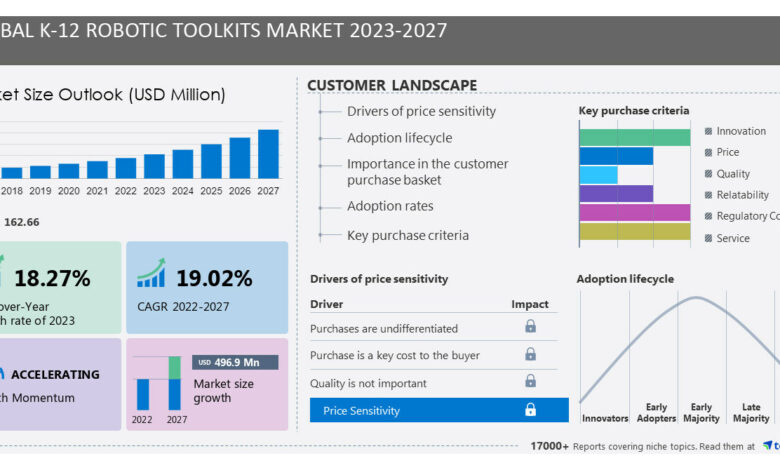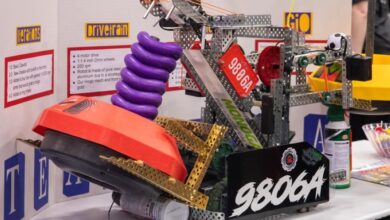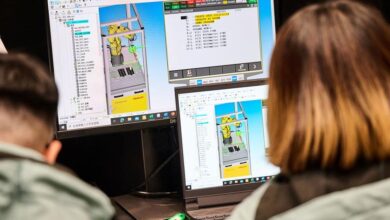K-12 Robotic Toolkits Market size is set to grow by USD 496.9 million from 2023-2027, product premiumization due to technological advances boost the market, Technavio

NEW YORK, April 22, 2024 /PRNewswire/ — The global K-12 robotic toolkits market size is estimated to grow by USD 496.9 mn from 2023-2027, according to Technavio. The market is estimated to grow at a CAGR of 19.02% during the forecast period. The K-12 robotic toolkits market is increasingly competitive, driven by customer preferences for multi-functional tools and technological advances. Growing purchasing power and the digital age fuel demand for premium toolkits for home use. Key factors include online communities, system integrators, educational curriculum, project-based learning, and inquiry-based learning. Pricing, industry partnerships, and STEM education are priority areas for vendors. Political factors and social scenarios also impact the market. Tools include drones, cartography, and robotics.
For more insights on the historic (2017 – 2021) and forecast market size– Request a sample report
|
K-12 Robotic Toolkits Market Scope |
|
|
Report Coverage |
Details |
|
Base year |
2022 |
|
Historic period |
2017 – 2021 |
|
Forecast period |
2023-2027 |
|
Growth momentum & CAGR |
Accelerate at a CAGR of 19.02% |
|
Market growth 2023-2027 |
USD 496.9 million |
|
Market structure |
Fragmented |
|
YoY growth 2022-2023 (%) |
18.27 |
|
Regional analysis |
North America, Europe, APAC, South America, and |
|
Performing market contribution |
North America at 39% |
|
Key countries |
US, China, South Korea, Japan, and Germany |
|
Key companies profiled |
Amtek Co. Inc., ArcBotics LLC, Boxlight Corp, |
Segment Overview
This k-12 robotic toolkits market report extensively covers market segmentation by Type (Science, Technology, Engineering, Mathematics, Others) School Level (High school, Middle school, PreK-elementary school) Geography (North America, Europe, APAC, South America, Middle East and Africa)
Geography Overview
The K-12 robotic toolkits market in North America is experiencing robust growth, driven by the integration of STEM education into the curriculum. The US, as the leading country in this market, accounted for the largest share in 2022. Innovative products, online purchasing platforms, and increasing school enrollment are key growth factors. However, economic conditions may pose challenges. Robotic toolkits foster STEM professions through degree programs, incorporating technologies like drones and cartography with coordinate mapping. Robotics and designing processes engage PreK-elementary students. Product pricing, political factors, and social scenarios influence the company industry’s strategic approaches. The Ace matrix, modular components, sensors, and motors are essential features of these toolkits. Programming interfaces prepare the future workforce for technology-driven industries. Educational institutions integrate mathematics, physics, computer science, and engineering into their curricula using educational software and online resources. Intuitive interfaces, age-appropriate challenges, online communities, and forums cater to the digital age’s learning needs. System integrators and intermediaries facilitate the implementation of strategic approaches, strengths and weaknesses, success factors, and priorities and strategies. Project-based and inquiry-based learning, hands-on activities, and classroom engagement enhance teacher training.
Insights on the market contribution of various segments including country and region wise, historic (2017 – 2021) and forecast market size– Download a Sample Report
- The K-12 robotic toolkits market is expanding in developed and developing countries due to rising income levels and growing expat populations. These toolkits, which include STEM education and advanced infrastructure, focus on overall child development through methods like robotics and design processes. Key components include sensors, motors, programming interfaces, and educational software. The future workforce prioritizes STEM professions, necessitating robust educational institutions and age-appropriate challenges.
- K-12 robotic toolkits, popular in schools and colleges, offer modular components, sensors, motors, and programming interfaces for mathematics, physics, computer science, and engineering education. However, their high cost, ranging from USD130 to USD10,000, limits adoption, particularly in developing countries. Institutions provide access, but the cost includes profit margins and taxes. Key features include intuitive interfaces, age-appropriate challenges, online resources, and project-based learning. Success factors include industry partnerships, teacher training, and workforce development.
Insights on Market Drivers, trends, & Challenges, historic period(2017 – 2021) and forecast period(2023-2027)- Request a sample report!
Research Analysis
In the K-12 Robotic Toolkits market, STEM professions are increasingly utilizing robotic toolkits to prepare the future workforce for technology-driven industries. These toolkits incorporate modular components, including sensors and motors, which enable students to design processes and build robots. Drones and cartography applications offer age-appropriate challenges, integrating mathematics, physics, computer science, and engineering principles. Product pricing and competitive positioning are crucial factors, with intuitive interfaces and online communities enhancing user experience. Educational software and project-based learning facilitate hands-on activities, fostering a digital age mindset. System integrators play a vital role in the educational curriculum, ensuring seamless integration of these tools into the learning process. Programming interfaces and future workforce development are key considerations for companies in this sector.
Market Research Overview
The K-12 Robotic Toolkits market is a significant segment in the education technology industry. These toolkits, comprising of components like sensors, motors, and programming software, promote hands-on learning experiences in STEM (Science, Technology, Engineering, and Mathematics) subjects. The use of robotic toolkits in classrooms fosters problem-solving skills, creativity, and critical thinking among students. Programs like Scratch, Python, and Arduino are commonly used for programming robots. The market is projected to grow due to increasing government investments in STEM education and the rising trend of incorporating technology in classrooms. Additionally, the availability of various funding opportunities and grants further boosts the market’s growth.
About Technavio
Technavio is a leading global technology research and advisory company. Their research and analysis focuses on emerging market trends and provides actionable insights to help businesses identify market opportunities and develop effective strategies to optimize their market positions.
With over 500 specialized analysts, Technavio’s report library consists of more than 17,000 reports and counting, covering 800 technologies, spanning across 50 countries. Their client base consists of enterprises of all sizes, including more than 100 Fortune 500 companies. This growing client base relies on Technavio’s comprehensive coverage, extensive research, and actionable market insights to identify opportunities in existing and potential markets and assess their competitive positions within changing market scenarios.
Contacts
Technavio Research
Jesse Maida
Media & Marketing Executive
US: +1 844 364 1100
UK: +44 203 893 3200
Email: [email protected]
Website: www.technavio.com/
SOURCE Technavio



